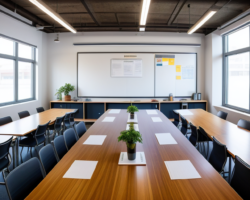Designing the perfect workshop layout is crucial for ensuring a productive and efficient work environment. Whether you are setting up a new workshop or looking to revamp an existing space, careful planning and consideration of key factors are essential. In this blog post, we will explore the various aspects of designing a workshop layout, including identifying key goals and objectives, analyzing space and infrastructure requirements, creating a functional flow within the workshop, optimizing accessibility and ergonomics, implementing efficient storage and organization solutions, integrating technology for enhanced productivity, and considering safety measures and regulations. By understanding and incorporating these elements into your workshop design, you can create a workspace that not only meets your specific needs but also enhances productivity and safety for everyone involved. We will break down each of these subtopics to provide you with practical tips and insights for designing a workshop layout that truly works for you.
Identifying Key Goals and Objectives
When setting up a workshop, it is crucial to identify key goals and objectives from the very beginning. This involves determining the purpose of the workshop and what the desired outcomes are. It could be to increase production, improve efficiency, or enhance safety measures. Understanding these goals and objectives will provide a clear direction for the workshop setup and design.
Moreover, identifying key goals and objectives also involves considering the specific needs and requirements of the team members who will be using the workshop. This could include their individual work processes, the tools and equipment they need access to, and the overall workflow within the space.
By identifying key goals and objectives early on, it becomes easier to make informed decisions about the layout, organization, and technology integration within the workshop. It ensures that every aspect of the setup is aligned with the overall purpose and desired outcomes, ultimately leading to a more efficient and productive workspace.
Ultimately, the process of identifying key goals and objectives sets the foundation for a successful and purpose-driven workshop, where every design element and operational aspect contributes to the overall goals and objectives of the space.
Analyzing Space and Infrastructure Requirements
When analyzing the space and infrastructure requirements for a workshop, it is essential to carefully consider the layout and dimensions of the available space. This includes evaluating the size and shape of the area, as well as assessing any potential constraints or limitations that may impact the design and functionality of the workshop.
Furthermore, it is important to take into account the specific infrastructure requirements for the workshop, such as electrical and plumbing needs, as well as any specialized equipment or machinery that will be utilized. This will help ensure that the workshop is equipped to support the intended activities and operations, and that all necessary resources are readily accessible.
Collaborating with architects, engineers, and other relevant professionals can also provide valuable insight and expertise when analyzing space and infrastructure requirements. Their input can help identify potential challenges and opportunities, and contribute to the development of a comprehensive and effective plan.
By carefully analyzing the space and infrastructure requirements for a workshop, it becomes possible to create a well-organized, efficient, and functional environment that is conducive to productivity and success.
Creating a Functional Flow within the Workshop
Creating a functional flow within the workshop is essential for maximizing productivity and efficiency. By strategically organizing the layout of the workshop, employees can easily navigate through the space and access the tools and equipment they need to perform their tasks.
One way to achieve a functional flow is by categorizing different work areas based on the tasks that are performed within them. For example, a separate area can be designated for woodworking, metalworking, and assembly. This separation reduces the time spent moving between different workstations and minimizes the risk of accidents and injuries.
Another important aspect of creating a functional flow is to optimize the layout in a way that minimizes wasted movement and maximizes the use of available space. This can be achieved by strategically placing workbenches, storage units, and machinery to create a streamlined workflow. Additionally, ensuring that there is adequate space for maneuvering around the workshop is crucial for maintaining a safe and efficient work environment.
Implementing visual cues such as color-coded floor markings, signage, and labels can also help employees easily identify different areas and navigate through the workshop. Clear communication through visual aids further enhances the functional flow within the workshop, leading to improved productivity and overall organization.
Optimizing Accessibility and Ergonomics
When designing a workshop or workspace, it is crucial to optimize for accessibility and ergonomics. This means creating a space that is easy to navigate and promotes efficiency and safety for all users. One key aspect of optimizing accessibility is to ensure that the space is barrier-free and easily accessible for individuals of all abilities. This may involve wider doorways, ramps, and designated parking spaces. Additionally, it is important to consider the layout and placement of equipment and tools to ensure that they are easily reachable for all users.
Furthermore, ergonomics plays a vital role in the design of a workshop. It involves creating a space that is conducive to the well-being and efficiency of the individuals working in it. This can be achieved through the use of adjustable workstations, proper lighting, and ergonomic tools and equipment. By prioritizing ergonomics in the design of the workshop, it can help prevent work-related injuries and improve overall productivity.
Overall, optimizing accessibility and ergonomics in a workshop is essential for creating a space that is inclusive, safe, and promotes productivity. By considering the needs of all users and prioritizing ergonomic design principles, it is possible to create a space that is efficient and conducive to the well-being of all individuals.
Implementing these measures may require careful planning and investment, but the long-term benefits in terms of safety, productivity, and employee satisfaction make it a worthwhile endeavor.
Implementing Efficient Storage and Organization Solutions
When it comes to optimizing the efficiency of a workshop, one of the key aspects to consider is efficient storage and organization solutions. Having a well-organized workspace can make a significant impact on productivity and overall functionality.
There are several ways to implement efficient storage and organization solutions in a workshop. Utilizing adjustable shelving units can help maximize vertical space and accommodate various tools and materials. Additionally, investing in storage bins and drawers with clear labels can make it easier to locate and access items when needed.
Another important aspect to consider is the layout of the workshop. Creating designated workstations for different tasks and keeping commonly used tools within arm’s reach can improve workflow and eliminate unnecessary movement around the space.
Furthermore, integrating digital organization tools, such as inventory management software and digital asset tracking systems, can streamline the process of tracking and managing workshop resources.
Integrating Technology for Enhanced Productivity
Integrating cutting-edge technology into your workspace can significantly enhance productivity and efficiency. By leveraging advanced software, automation tools, and smart devices, businesses can streamline various processes and workflows, ultimately driving better results. Whether it’s implementing project management software to improve collaboration and communication or utilizing advanced data analytics tools to gain valuable insights, technology can be a game-changer in today’s fast-paced work environment.
Moreover, integrating technology can also result in cost savings and resource optimization. For instance, adopting cloud-based solutions can reduce the need for physical storage and minimize the risk of data loss. Similarly, by automating repetitive tasks and leveraging artificial intelligence, businesses can free up valuable time and resources, allowing employees to focus on more strategic and innovative initiatives.
Furthermore, technology integration enables businesses to stay ahead of the curve and remain competitive in the market. Whether it’s implementing customer relationship management (CRM) software to enhance customer satisfaction or adopting cutting-edge manufacturing technologies to improve production processes, staying updated with the latest technological advancements is crucial for sustained growth and success.
Overall, integrating technology for enhanced productivity is essential for businesses looking to adapt to the modern work landscape. By embracing innovation and digital tools, organizations can unlock new opportunities, drive better outcomes, and foster a culture of continuous improvement.
Considering Safety Measures and Regulations
When designing a workshop, it is crucial to prioritize the safety measures and regulations that need to be implemented. This ensures the well-being of everyone who will be working in the space, as well as compliance with legal requirements. One of the key aspects to consider is the use of proper protective equipment, such as goggles, gloves, and ear protection, depending on the type of work being done in the workshop. Making sure that these items are readily available and clearly marked is essential for the safety of the workers.
Another important consideration when it comes to safety measures and regulations is the layout of the workshop. It is essential to ensure that there is enough space between machinery and workstations to prevent accidents. Additionally, all electrical installations should be up to code, and fire safety measures, such as fire extinguishers and emergency exits, should be clearly marked and easily accessible.
Implementing proper training and guidelines for the use of equipment and tools is another vital safety measure that needs to be considered. This includes providing thorough training on how to operate machinery and tools safely, as well as regular reminders to follow safety protocols. This not only reduces the risk of accidents but also ensures that everyone in the workshop is aware of the necessary safety procedures.
Finally, keeping up with the latest regulations and safety standards is crucial to maintaining a safe and compliant workshop. This may involve regular checks and audits to ensure that everything is up to code, as well as staying informed about any updates to safety regulations that may affect the workshop. By staying proactive and informed, the workshop can maintain a safe and productive environment for everyone involved.





